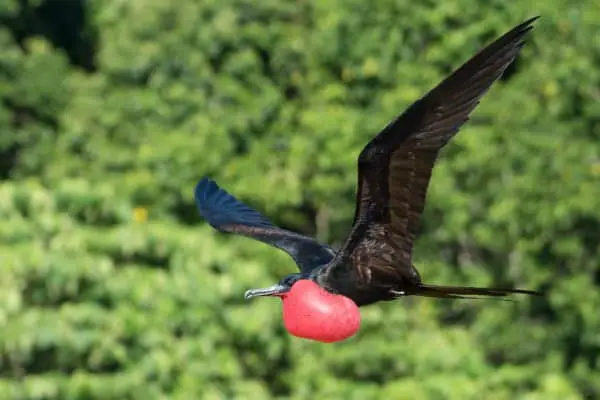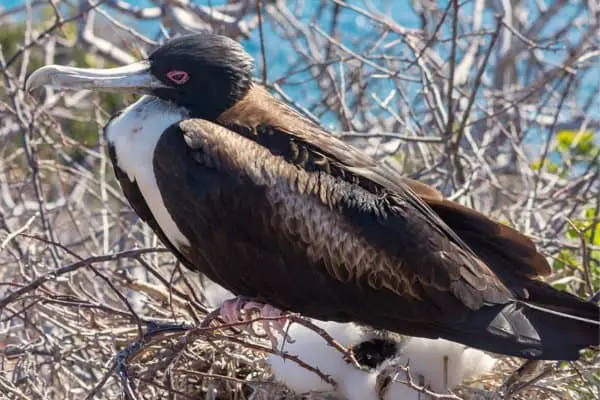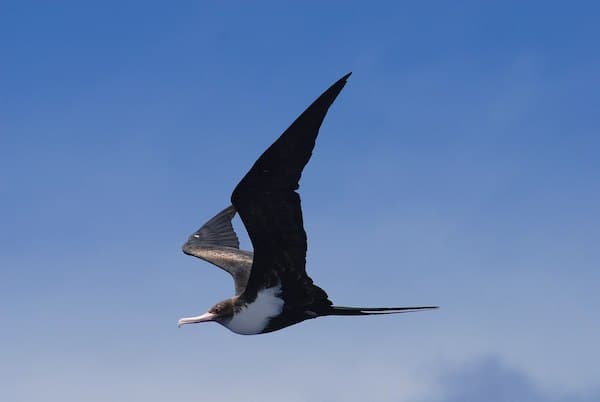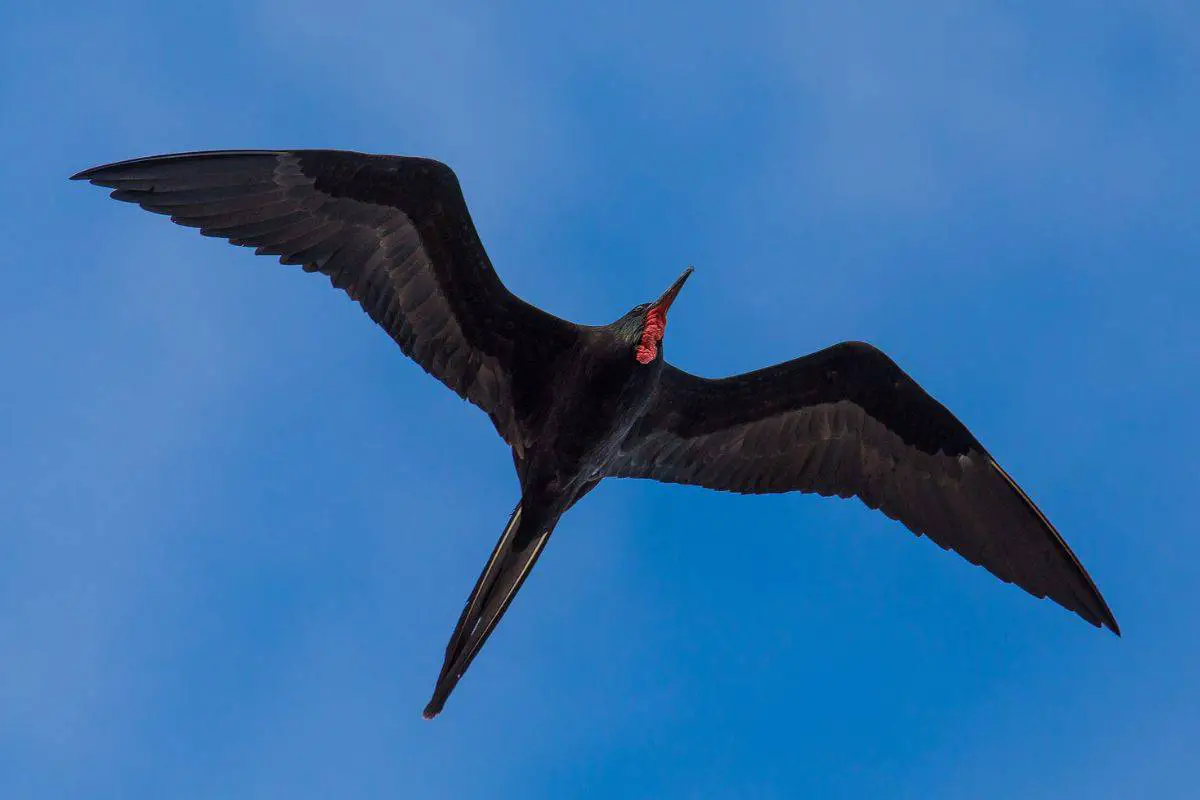Common Name: Great Frigatebird
Scientific Name: (Fregata minor)| Size | Diet | Range in Hawaii | Status in Hawaii |
|---|---|---|---|
| 91 in. | fish, squid, and other marine creatures | Northwestern Hawaiian Islands | Least Concern |
The Great Frigatebird, also known as Fregata minor, is a seabird species that is native to the tropical and subtropical regions of the world. The species is also an indigenous breeding visitor to Hawaii, where it has been a part of the islands’ natural ecosystem for centuries. With its striking appearance and unique behavior, the Great Frigatebird is a fascinating bird species that has captured the attention of birdwatchers and avian enthusiasts around the world.
In this article, we will explore the world of the Great Frigatebird, its unique characteristics, and its presence in Hawaii.
Great frigatebird
Appearance

The Great Frigatebird is a true marvel of nature, boasting an appearance that leaves onlookers in awe. With a wingspan of up to 7.5 feet (about 91 inches), this majestic seabird is an imposing sight in the skies.
Its jet-black plumage contrasts strikingly against the azure skies, creating an aura of elegance and grace. But what truly captures attention is the male’s inflatable, bright-red throat pouch, which swells impressively during courtship displays, adding a mesmerizing touch to its already stunning appearance.
Diet
This master of the skies has a taste for adventure, relying primarily on a diet of fish, squid, and other marine creatures. However, what sets it apart is its ingenious foraging technique – it’s a consummate pirate of the skies!
Nesting
Rather than building traditional nests on the ground or in trees, the Great Frigatebirds prefer to nest in dense colonies on remote, rocky islands or coastal cliffs. These nesting sites offer protection from terrestrial predators and ensure their young are safe from harm.
Mating displays play a crucial role in the courtship process. Male Frigatebirds showcase their captivating red throat pouches, puffing them up like vibrant balloons to attract potential mates. They engage in elaborate aerial displays, showcasing their prowess in mid-air acrobatics.
Once a pair forms a bond, the female lays a single egg, which both parents take turns incubating. Interestingly, the incubation period is quite lengthy, lasting around 50 days, making it one of the longest among seabirds.
What’s truly unique about the nesting behavior of the Great Frigatebird is its chick-rearing approach. Once the chick hatches, it is completely dependent on its parents for nourishment. The mother provides the essential nutrients through regurgitation, while the father ventures out to forage for food and returns to feed the chick directly.
This division of parental duties, with the mother taking on a more extended incubation role and the father providing sustenance, showcases a fascinating cooperative parenting system in the bird world. As the chick grows, it faces the challenge of developing strong wing muscles before it can take its first flight. This period is critical as the young bird needs to be able to master the art of flying before it ventures into the vast ocean.
Behavior

One of the most mesmerizing behaviors of the male Frigatebird is its elaborate courtship display. During the breeding season, males gather in colonies and puff up their vibrant red throat pouches to impressive proportions, resembling inflated balloons.
They engage in elaborate wing-flapping displays, producing distinctive drumming sounds to attract females. This grand spectacle, combined with their elegant flight maneuvers, is a breathtaking sight to behold.
However, it’s not all grand displays and glamour for the Great Frigatebird. To secure a mate, males must also exhibit impressive aerial piracy skills.
They swoop down on other seabirds, forcing them to regurgitate their recent meals, and then seize the opportunity to snatch the regurgitated food in mid-air. This kleptoparasitic behavior has earned them the nickname “pirates of the skies.”
Beyond their flashy courtship rituals, Frigatebirds exhibit fascinating social dynamics within their colonies. Living in dense communities, they engage in complex interactions, establishing hierarchies and defending territories. Aggressive confrontations are common during the nesting season, as they vie for limited nesting spots and resources.
Habitat
The Great Frigatebird is a true icon of the open ocean, and its habitat reflects its affinity for the vast blue expanse. These majestic seabirds are predominantly found in tropical and subtropical regions, favoring remote and uninhabited islands, as well as coastal cliffs and rocky outcrops. In addition to their mastery of the open ocean, Great Frigatebirds are equally at home over the calmer waters of lagoons and sheltered bays, where they engage in their dazzling courtship displays during the breeding season.
Range
The Great Frigatebird is an indigenous breeding visitor to the Hawaiian Islands, primarily found in the Northwestern Hawaiian Islands. It breeds on all Northwestern Hawaiian Islands except Gardner Pinnacles, with the largest breeding colony found on Nihoa.
Roosting sites are also observed off the Southeastern islands, with Kaula Rock, Lehua Islet, and Mokuaeae Islet being notable roosting locations. The Great Frigatebird’s presence in Hawaii dates back at least 200,000 years, with fossil records found in Ulupau Head, O’ahu.
Conservation Status

The conservation status of the Great Frigatebird (Fregata minor) is currently classified as “Least Concern” by the International Union for Conservation of Nature (IUCN). Despite being a pantropical species, the Great Frigatebird faces some localized threats and challenges.
Interesting Facts
1. Name “frigatebird” origin
The name “frigatebird” originates from the French word “frégate,” referring to the bird’s resemblance to the fast and maneuverable frigate warships.
2. No waterproofing
Unlike most seabirds, Great Frigatebirds lack waterproof feathers, making them unable to swim or rest on water. They are entirely reliant on their aerial skills, staying aloft for days without ever landing on the water.
3. Energy conservation
To minimize energy expenditure during long flights, Great Frigatebirds have special adaptations. They can drink seawater, which allows them to stay hydrated without the need to land for freshwater sources.
4. Nonstop flying
Great Frigatebirds are capable of staying in the air for extended periods without landing. They use their keen eyesight to spot prey from high above and utilize thermals and winds to stay airborne for days, even sleeping on the wing.
5. Gender dimorphism
Male and female Great Frigatebirds display distinct differences in appearance. Males have a striking black plumage with iridescent green sheen, while females have a white breast and belly.
Frequently Asked Questions
1. Do Great Frigatebirds have any predators?
As top predators of the skies and oceans, Great Frigatebirds have few natural predators. However, their eggs and chicks may be vulnerable to predation by large seabirds, such as gulls and skuas, or introduced predators like rats on some islands.
2. Do Great Frigatebirds have any cultural significance?
Great Frigatebirds have cultural significance in various regions where they are found. In some Pacific cultures, they are symbols of power, freedom, and navigation, while in others, they are associated with myths and stories about the origins of the islands.
3. Can Great Frigatebirds be kept as pets?
Keeping Great Frigatebirds as pets is not recommended and is often illegal due to their protected status and specific habitat requirements. They are wild seabirds best suited to their natural environment and should be appreciated and conserved in the wild.
4. How do Great Frigatebirds sleep while flying?
During their long flights, Great Frigatebirds employ a unique resting technique called “torpor.” They shut down one hemisphere of their brain at a time, allowing them to rest while staying alert to potential dangers and maintaining their flight.
5. How do Great Frigatebirds cope with strong winds during flight?
Great Frigatebirds are well adapted to soaring in strong winds. They use their long, slender wings to harness updrafts and take advantage of wind currents, enabling them to glide effortlessly for extended periods without flapping their wings.




